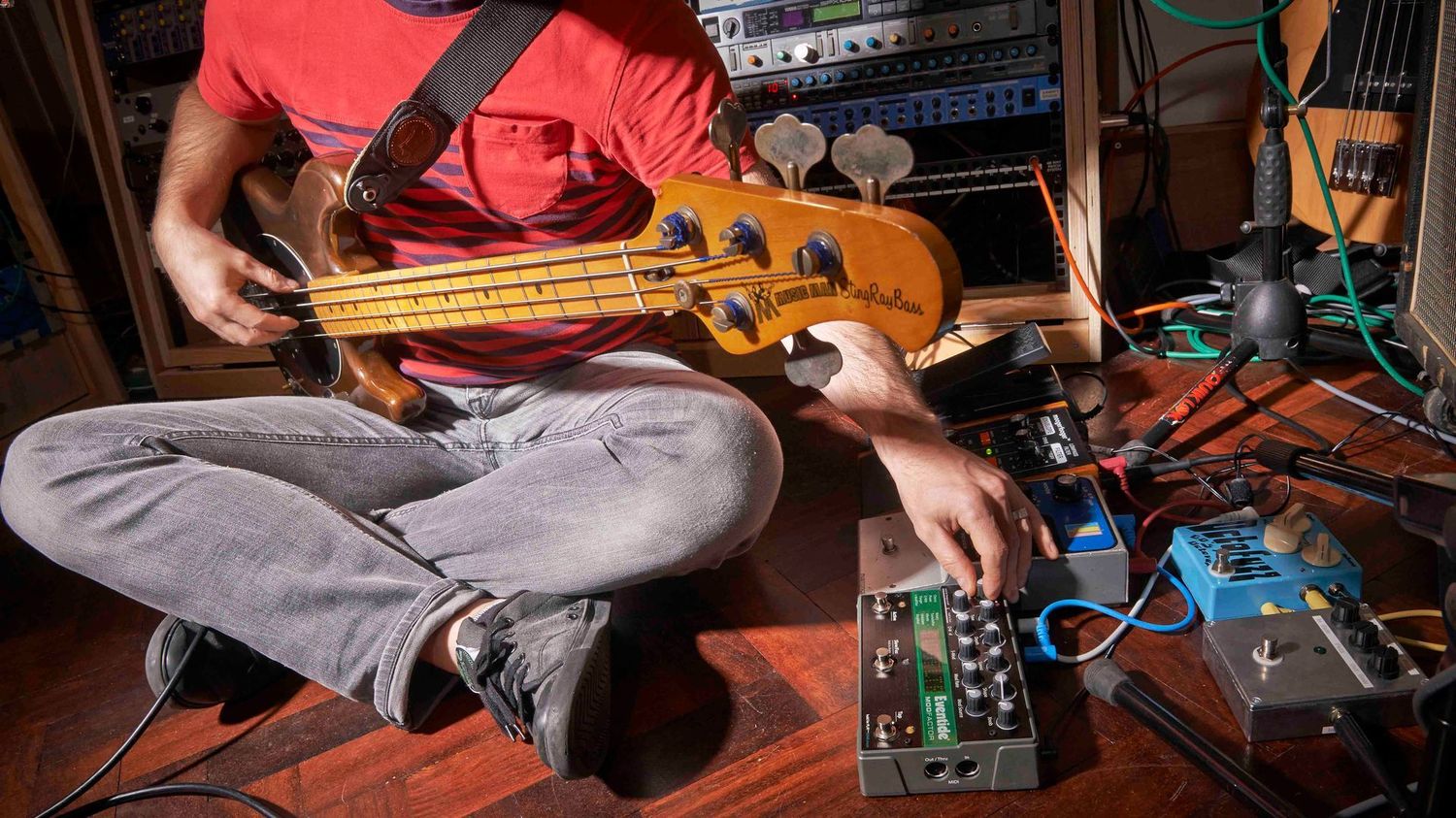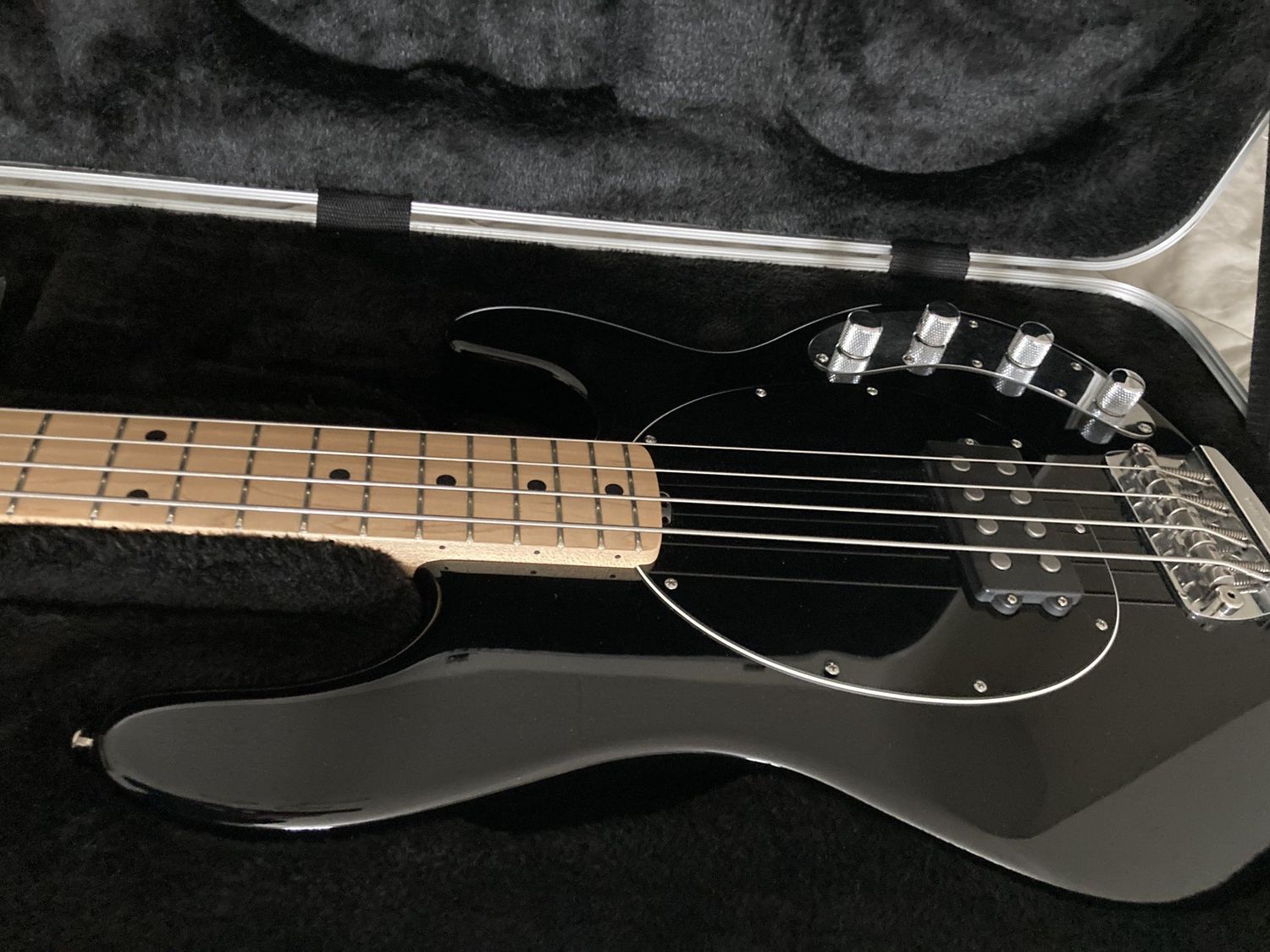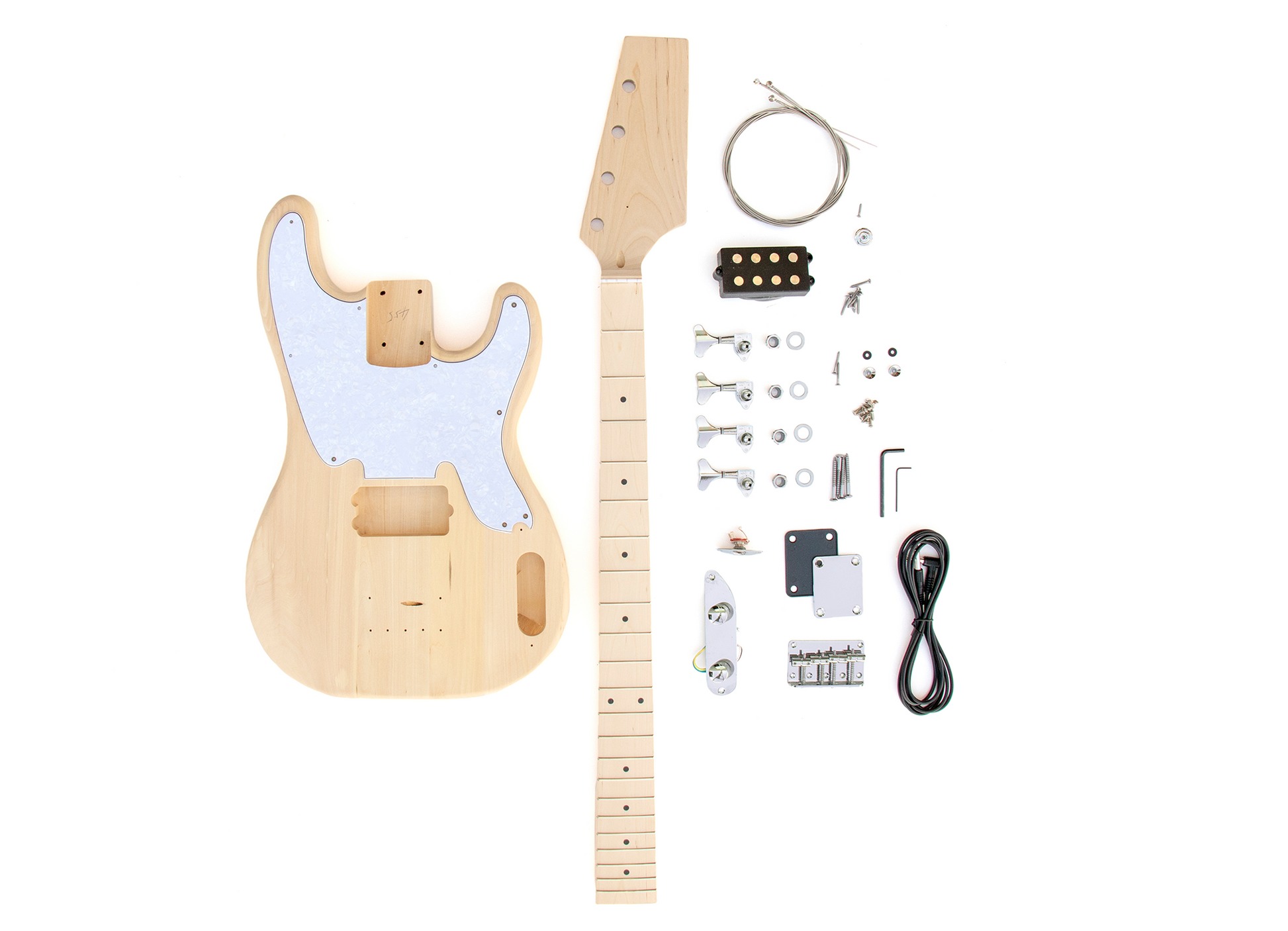Home>Instruments>Guitar>How To Play The Bass Guitar For Dummies


Guitar
How To Play The Bass Guitar For Dummies
Published: February 13, 2024
Learn how to play the bass guitar with step-by-step guidance for beginners. Master the basics and start jamming with confidence. Perfect for guitar enthusiasts!
(Many of the links in this article redirect to a specific reviewed product. Your purchase of these products through affiliate links helps to generate commission for AudioLover.com, at no extra cost. Learn more)
Table of Contents
- Introduction
- Chapter 1: Getting Started with the Bass Guitar
- Chapter 2: Understanding the Basics of Music Theory
- Chapter 3: Mastering Essential Bass Guitar Techniques
- Chapter 4: Learning Popular Bass Guitar Styles
- Chapter 5: Expanding Your Bass Guitar Skills
- Chapter 6: Exploring Advanced Bass Guitar Techniques
- Chapter 7: Tips for Improving Your Bass Guitar Playing
- Chapter 8: Troubleshooting Common Bass Guitar Problems
- Chapter 9: The Part of Tens: Ten Bass Guitar Legends and Ten Essential Bass Guitar Songs
- Chapter 10: Ten (or So) Great Bass Guitar Resources
Introduction
So, you've decided to pick up the bass guitar and embark on a musical journey that promises excitement, creativity, and endless opportunities for expression. Whether you're a complete novice or a seasoned musician exploring a new instrument, learning to play the bass guitar can be a fulfilling and rewarding experience. This comprehensive guide is designed to equip you with the essential knowledge and skills to start playing the bass guitar with confidence and finesse.
The bass guitar, often overshadowed by its six-stringed counterpart, holds a crucial role in shaping the rhythmic and harmonic foundation of any musical ensemble. As the heartbeat of the band, the bass guitar provides the fundamental groove and connects the rhythm section with the melody, serving as a bridge between harmony and rhythm. Its deep, resonant tones add depth and richness to the music, anchoring the composition and driving the overall sound forward.
In this guide, we will delve into the intricacies of the bass guitar, exploring its unique characteristics, fundamental techniques, and diverse playing styles. From understanding the basics of music theory to mastering advanced playing techniques, each chapter will offer valuable insights and practical tips to elevate your bass guitar playing skills. Additionally, we'll take a closer look at the influential figures in the world of bass guitar and uncover the timeless classics that have shaped the instrument's legacy.
Whether you aspire to lock into a tight groove with a band, unleash thunderous bass lines in a rock anthem, or explore the melodic possibilities of the instrument, this guide will serve as your roadmap to mastering the art of bass guitar playing. So, grab your bass guitar, tune up, and get ready to embark on an enriching and melodious adventure that transcends boundaries and resonates with the soul. Let's dive in and unlock the rhythmic potential of the bass guitar together!
Chapter 1: Getting Started with the Bass Guitar
Embarking on a journey with the bass guitar begins with understanding its anatomy and functionality. The bass guitar, with its four strings and longer neck, differs from the standard six-string guitar, offering a unique sonic palette and rhythmic prowess. Before diving into playing techniques and musical theory, it’s essential to familiarize yourself with the instrument itself.
As you acquaint yourself with the bass guitar, consider the following key components:
- The Body: The body of the bass guitar, typically larger than that of an electric guitar, houses the pickups, bridge, and controls. Understanding the body’s contours and weight distribution is crucial for achieving comfort and maneuverability while playing.
- The Neck and Fretboard: The neck of the bass guitar extends to accommodate the longer scale length and four strings. Familiarizing yourself with the fretboard’s layout, fret markers, and fret spacing will aid in navigating the instrument with precision.
- The Tuning Pegs: Tuning pegs, located on the headstock, allow for precise tuning of each string. Learning to tune the bass guitar accurately is fundamental for achieving optimal tonal quality.
- The Pickups and Controls: Understanding the function of pickups and control knobs empowers you to manipulate the instrument’s sound, from adjusting volume and tone to exploring different tonal textures.
Once you’ve familiarized yourself with the instrument, it’s time to explore the foundational techniques of playing the bass guitar. From mastering proper playing posture and hand positioning to developing a strong sense of rhythm and timing, these fundamental skills form the bedrock of your bass guitar journey.
Remember, every great bassist started as a beginner, learning the ropes and gradually honing their craft. Embrace the learning process, stay patient and persistent, and most importantly, let your passion for music be your guiding light. With a solid understanding of the bass guitar’s anatomy and a willingness to embark on this musical odyssey, you’re well on your way to becoming a proficient bassist. Let’s dive deeper into the world of bass guitar playing and unlock the rhythmic potential that awaits!
Chapter 2: Understanding the Basics of Music Theory
Delving into the realm of music theory is a pivotal step in expanding your proficiency as a bass guitarist. While the instrument’s rhythmic prowess is undeniable, a solid grasp of music theory empowers you to navigate the harmonic landscape with finesse and creativity. Let’s unravel the fundamental elements of music theory that will enrich your bass guitar journey.
Notes, Scales, and Intervals: Familiarize yourself with the musical alphabet, comprising the notes A, B, C, D, E, F, and G, which form the building blocks of melodies and harmonies. Understanding scales, such as the major and minor scales, equips you with the tools to construct melodic phrases and navigate the fretboard with precision. Additionally, delving into intervals, the distance between two notes, enhances your ability to create captivating bass lines and melodic motifs.
Chords and Harmony: While the bass guitar primarily operates in the lower register, comprehending chord structures and harmonic progressions is invaluable. Explore the construction of chords and their inversions, and grasp the role of the bass in underpinning harmonic sequences, providing a solid foundation for the entire musical ensemble.
Rhythmic Notation and Time Signatures: Mastering rhythmic notation and time signatures is essential for anchoring the groove and propelling the music forward. Understanding rhythmic values, such as whole notes, half notes, quarter notes, and their respective rests, enables you to lock into the rhythmic pulse and execute dynamic bass lines with precision.
Ear Training and Transcription: Cultivating your ear for music through active listening and transcription exercises hones your ability to discern bass lines, melodies, and harmonic progressions by ear. This skill enhances your musical vocabulary and fosters a deeper understanding of various musical styles and genres.
By immersing yourself in the foundational principles of music theory, you will not only enhance your bass guitar playing but also elevate your overall musicianship. Embrace the theoretical underpinnings of music with curiosity and enthusiasm, and witness how it transforms your approach to the instrument. With a solid grasp of music theory, you’ll embark on a musical journey enriched with creativity, expression, and a profound understanding of the language of music.
Chapter 3: Mastering Essential Bass Guitar Techniques
As you venture deeper into the world of bass guitar playing, mastering essential techniques is paramount for honing your skills and unleashing the instrument’s sonic potential. From establishing a solid foundation in fingerstyle and pick playing to exploring the nuances of slap and pop techniques, the art of bass guitar playing is a dynamic tapestry of diverse approaches and expressive possibilities.
Fingerstyle Technique: Embracing the fingerstyle technique, where you pluck the strings with your fingertips, allows for nuanced control over dynamics and tone. By mastering fingerstyle, you can produce rich, resonant tones and execute intricate melodic passages with finesse, enhancing the rhythmic and harmonic tapestry of the music.
Pick Playing: Utilizing a pick, also known as a plectrum, offers a distinct articulation and attack, ideal for driving energetic rhythms and unleashing powerful bass lines. Exploring pick playing techniques equips you with the versatility to adapt your playing style to various musical genres, from rock and punk to metal and beyond.
Slap and Pop: The iconic slap and pop techniques, popularized by funk and fusion bassists, infuse the music with percussive flair and rhythmic vitality. Mastering these techniques involves employing your thumb to create a percussive “slap” on the strings and using your other fingers to execute vibrant “pop” accents, adding a distinctive groove to the music.
Hammer-Ons and Pull-Offs: Incorporating hammer-ons and pull-offs into your playing enhances the fluidity and expressiveness of your bass lines, allowing for seamless transitions between notes and fostering a legato playing style. These techniques facilitate the creation of captivating melodic phrases and embellishments, elevating the melodic dimension of your bass guitar playing.
By immersing yourself in these essential bass guitar techniques, you’ll expand your sonic repertoire and cultivate a versatile skill set that adapts to a myriad of musical contexts. Embrace the nuances of each technique, experiment with different playing styles, and infuse your playing with creativity and expression. With dedication and practice, you’ll harness the power of these techniques to craft compelling bass lines and leave an indelible mark on the musical canvas.
Chapter 4: Learning Popular Bass Guitar Styles
Exploring diverse bass guitar styles opens a gateway to a rich tapestry of musical expression, allowing you to immerse yourself in a spectrum of genres and sonic landscapes. Each style carries its own unique characteristics, rhythmic nuances, and melodic sensibilities, offering an enriching journey for bass guitar enthusiasts seeking versatility and creative exploration.
Rock and Blues: The driving force behind countless iconic rock anthems, the bass guitar in rock and blues music commands attention with its pulsating rhythms and assertive presence. Embracing the foundational role of the bass in these genres involves anchoring the groove, crafting memorable bass lines, and infusing the music with raw energy and attitude.
Funk and R&B: In the realm of funk and R&B, the bass guitar takes on a central role, driving infectious grooves and laying down irresistibly funky bass lines. Mastering the rhythmic precision, syncopated patterns, and dynamic articulations synonymous with these styles empowers you to create a deep pocket and infuse the music with irresistible danceability.
Jazz and Fusion: Jazz and fusion bass guitar styles epitomize sophistication and improvisational prowess, requiring a keen understanding of harmonic progressions, walking bass lines, and melodic embellishments. Embrace the harmonic intricacies of jazz standards and the fusion genre’s fusion of diverse influences, and delve into the art of melodic improvisation and expressive soloing.
Latin and World Music: The bass guitar in Latin and world music genres adds a rich tapestry of rhythmic textures and melodic motifs, reflecting diverse cultural influences and rhythmic traditions. From the buoyant rhythms of salsa and mambo to the evocative melodies of flamenco and Afrobeat, these styles invite you to explore polyrhythmic patterns and vibrant tonalities.
By immersing yourself in these popular bass guitar styles, you’ll expand your musical horizons, develop a nuanced understanding of diverse rhythmic traditions, and cultivate a versatile playing style that transcends genre boundaries. Embrace the distinct characteristics of each style, study influential bassists within these genres, and infuse your playing with the expressive nuances that define each musical landscape. With a deep appreciation for diverse bass guitar styles, you’ll embark on a musical odyssey that celebrates the boundless creativity and expressive potential of the instrument.
Chapter 5: Expanding Your Bass Guitar Skills
As you continue your bass guitar journey, the quest for skill expansion becomes an exhilarating pursuit, offering boundless opportunities for growth and musical exploration. This chapter delves into avenues for broadening your bass guitar skills, from embracing advanced playing techniques to cultivating a deep understanding of musical composition and arrangement.
Advanced Playing Techniques: Elevate your playing prowess by delving into advanced techniques such as double stops, harmonics, tapping, and chordal playing. These techniques unlock new dimensions of expression, allowing you to craft intricate bass lines, melodic flourishes, and dynamic textures that elevate your musical contributions.
Understanding Music Composition: Embrace the art of music composition and songwriting, honing your ability to craft compelling bass lines and contribute to the overall sonic tapestry. Explore song structure, chord progressions, and melodic development, and cultivate a keen ear for creating bass parts that enhance the music’s emotional impact.
Collaborative Playing and Ensemble Skills: Engage in collaborative playing experiences, whether jamming with fellow musicians, joining a band, or participating in ensemble settings. Developing ensemble skills nurtures your ability to lock into a groove, communicate musically with other instrumentalists, and contribute to a cohesive, synergistic musical experience.
Exploring Music Production and Recording: Familiarize yourself with the fundamentals of music production and recording techniques, gaining insight into studio environments, signal processing, and the role of the bass in shaping the overall sonic landscape. Understanding the recording process equips you to adapt your playing for studio contexts and contribute effectively to recorded music projects.
By embarking on this journey of skill expansion, you’ll enrich your musical vocabulary, deepen your understanding of the bass guitar’s role in diverse musical contexts, and cultivate a versatile skill set that transcends traditional boundaries. Embrace the challenges and rewards of skill expansion, and let your passion for musical exploration propel you toward new horizons of creative expression and technical proficiency.
Chapter 6: Exploring Advanced Bass Guitar Techniques
Delving into advanced bass guitar techniques unveils a world of sonic possibilities, allowing you to push the boundaries of traditional playing and infuse your music with captivating intricacies and expressive nuances. As you embark on this exploration, you’ll encounter a diverse array of techniques that elevate your playing to new heights, expanding your sonic palette and enriching your musical vocabulary.
Double Stops and Chordal Playing: Embrace the art of double stops, where you play two notes simultaneously, and delve into chordal playing, creating rich harmonies and textures on the bass guitar. These techniques add depth and harmonic complexity to your playing, enabling you to craft lush, multi-voiced arrangements and expand your role within the musical ensemble.
Tapping and Two-Handed Techniques: Venture into the realm of tapping, employing both hands to execute rapid note sequences and cascading arpeggios on the fretboard. By integrating tapping and two-handed techniques, you’ll unleash a torrent of melodic possibilities, infusing your bass lines with dazzling virtuosity and dynamic flair.
Harmonics and Artificial Techniques: Explore the ethereal realm of harmonics, where you produce bell-like tones by lightly touching the strings at specific nodal points. Additionally, experiment with artificial techniques such as string bending and pitch modulation, adding expressive ornamentation and tonal variation to your bass guitar repertoire.
Extended Range and Soloing: Embrace extended range bass guitars, featuring additional strings and expanded tonal capabilities, and delve into the art of soloing on the bass. Navigating the extended range empowers you to explore subterranean lows and soaring highs, while honing your soloing skills enables you to command the spotlight with melodic ingenuity and improvisational prowess.
By immersing yourself in advanced bass guitar techniques, you’ll cultivate a dynamic and multifaceted playing style, infusing your music with an unparalleled level of creativity and technical proficiency. Embrace the challenges of mastering these techniques, experiment with their application across diverse musical genres, and let your artistic vision soar as you unlock the full potential of the bass guitar.
Chapter 7: Tips for Improving Your Bass Guitar Playing
Enhancing your bass guitar playing involves a multifaceted approach that encompasses technical refinement, musical understanding, and a deep connection with the instrument. This chapter presents a collection of invaluable tips and strategies aimed at elevating your playing, fostering a deeper musical connection, and nurturing a lifelong journey of growth and expression.
- Consistent Practice: Dedicate regular time to practice, focusing on technique, repertoire, and musical exploration. Consistency is key to building muscle memory, refining your playing, and internalizing musical concepts.
- Ear Training: Cultivate your ear for music through active listening, transcribing bass lines, and honing your ability to discern pitch, rhythm, and tonal nuances. Ear training enhances your musical perception and fosters a deeper connection with the music you play.
- Rhythmic Precision: Develop a strong sense of rhythm and timing, anchoring the groove with unwavering precision and propelling the music forward with dynamic rhythmic interplay.
- Exploration of Diverse Genres: Embrace a diverse range of musical genres, studying influential bassists across various styles and integrating elements from different genres into your playing repertoire.
- Collaborative Musicianship: Engage in collaborative playing experiences, actively listening to other musicians, and communicating musically to create cohesive, synergistic musical moments.
- Performance Confidence: Seek opportunities to perform live, whether in jam sessions, open mic nights, or formal gigs. Embracing live performance nurtures confidence, stage presence, and adaptability in diverse musical settings.
- Continuous Learning: Maintain a thirst for knowledge and growth, seeking out educational resources, instructional materials, and mentorship to expand your musical horizons and refine your craft.
By integrating these tips into your bass guitar journey, you’ll cultivate a holistic approach to improvement, nurturing not only technical proficiency but also a deep musical understanding and a profound connection with the instrument. Embrace the joy of continual growth, celebrate your progress, and let the music guide you on an enriching path of artistic expression and instrumental mastery.
Chapter 8: Troubleshooting Common Bass Guitar Problems
As a bass guitarist, encountering technical challenges and instrument-related issues is a natural part of the musical journey. This chapter addresses common problems that bassists may encounter and offers practical solutions to troubleshoot these issues, ensuring that your playing experience remains smooth, enjoyable, and free from impediments.
- Intonation and Tuning Stability: Address intonation issues by adjusting the saddle positions and ensuring proper string length, while maintaining tuning stability through regular string changes, proper string winding, and lubrication of the nut and bridge contact points.
- Fret Buzz and Action Adjustment: Mitigate fret buzz by evaluating neck relief, adjusting string action, and addressing uneven frets to achieve optimal playability and sustain.
- Electronics and Wiring: Troubleshoot electronic problems by checking for loose connections, corroded contacts, and faulty components, ensuring that your bass guitar’s pickups, controls, and output jack function reliably.
- String and Pickup Height: Adjust string and pickup height to optimize string-to-string balance, tonal clarity, and sustain, tailoring the instrument’s setup to suit your playing style and sonic preferences.
- Environmental Considerations: Protect your bass guitar from environmental factors such as temperature and humidity fluctuations, employing proper storage and maintenance practices to safeguard the instrument’s structural integrity and tonal consistency.
- Instrument Maintenance: Implement a regular maintenance routine encompassing cleaning, conditioning, and inspection of the instrument’s components, safeguarding its playability and longevity.
By proactively addressing these common bass guitar problems and implementing effective troubleshooting strategies, you’ll ensure that your instrument remains in optimal playing condition, empowering you to focus on musical expression and creativity without the hindrance of technical impediments. Embrace the role of a caretaker for your instrument, and cultivate a deep understanding of its mechanics to foster a harmonious and enduring musical partnership.
Chapter 9: The Part of Tens: Ten Bass Guitar Legends and Ten Essential Bass Guitar Songs
Exploring the influential figures and timeless compositions within the realm of bass guitar unveils a tapestry of creativity, innovation, and sonic brilliance. This chapter celebrates the indelible contributions of ten legendary bass guitarists and presents a curated selection of ten essential bass guitar songs that have left an enduring imprint on the musical landscape.
Ten Bass Guitar Legends
- Jaco Pastorius: Revered for his virtuosic fretless bass playing and pioneering fusion style, Jaco Pastorius redefined the role of the bass guitar in modern music, leaving an indelible mark on jazz and beyond.
- James Jamerson: As a prominent figure at Motown Records, James Jamerson’s innovative bass lines defined the sound of countless hit songs, earning him acclaim as a trailblazer of groove-oriented bass playing.
- Carol Kaye: Renowned for her prolific studio work and contributions to iconic recordings, Carol Kaye’s versatile bass playing and melodic sensibilities have solidified her status as a trailblazing figure in popular music.
- Geddy Lee: The driving force behind Rush’s dynamic sound, Geddy Lee’s technical prowess and melodic inventiveness have established him as a progressive rock icon and a paragon of bass guitar virtuosity.
- Victor Wooten: A master of contemporary bass technique, Victor Wooten’s innovative approach, and unparalleled dexterity have redefined the possibilities of the bass guitar, inspiring a new generation of players.
- Tina Weymouth: As a founding member of Talking Heads, Tina Weymouth’s distinctive bass lines and rhythmic finesse have contributed to the band’s pioneering blend of new wave and art rock, cementing her influence in alternative music.
- John Entwistle: Revered for his thunderous bass sound and dynamic stage presence in The Who, John Entwistle’s groundbreaking approach to bass playing has left an enduring legacy in the realm of rock music.
- Stanley Clarke: A trailblazer of jazz fusion and electric bass virtuosity, Stanley Clarke’s innovative techniques and genre-defying compositions have solidified his status as a pioneering force in contemporary jazz and beyond.
- Les Claypool: Renowned for his eccentric style and genre-bending creativity, Les Claypool’s idiosyncratic bass playing with Primus has redefined the boundaries of alternative rock and alternative metal.
- Paul McCartney: A towering figure in popular music, Paul McCartney’s melodic bass lines and songwriting contributions with The Beatles have made an indelible impact on the evolution of rock and pop music.
Ten Essential Bass Guitar Songs
- “Another One Bites the Dust” – Queen: John Deacon’s iconic bass line in this timeless hit exemplifies the power of a simple yet irresistibly groovy bass riff.
- “Good Times” – Chic: Bernard Edwards’ infectious bass line in this disco classic embodies the essence of funk-infused dance music.
- “Come Together” – The Beatles: Paul McCartney’s hypnotic bass groove in this Beatles gem showcases his melodic ingenuity and rhythmic finesse.
- “YYZ” – Rush: Geddy Lee’s virtuosic bass playing in this progressive rock masterpiece exemplifies his technical prowess and innovative approach to the instrument.
- “Teen Town” – Weather Report: Jaco Pastorius’ fretless bass wizardry in this jazz fusion gem highlights his unparalleled melodic and improvisational abilities.
- “I Want You Back” – The Jackson 5: James Jamerson’s influential bass line in this Motown classic epitomizes the art of creating a memorable and propulsive groove.
- “Roundabout” – Yes: Chris Squire’s dynamic bass work in this progressive rock epic showcases his melodic inventiveness and commanding presence within the band’s sonic tapestry.
- “Cissy Strut” – The Meters: George Porter Jr.’s funky bass line in this New Orleans funk staple exemplifies the infectious rhythmic interplay and deep pocket of the genre.
- “Higher Ground” – Red Hot Chili Peppers (Stevie Wonder cover): Flea’s energetic and slap-driven bass performance in this cover pays homage to the funk-driven original while adding his distinctive flair.
- “Psycho Killer” – Talking Heads: Tina Weymouth’s minimalist yet captivating bass line in this new wave classic underscores her role as a pioneering figure in alternative music.
By celebrating the contributions of these legendary bassists and revisiting the timeless compositions that have shaped the bass guitar’s legacy, we honor the instrument’s profound impact on the world of music and the enduring inspiration it continues to provide to musicians and enthusiasts alike.
Chapter 10: Ten (or So) Great Bass Guitar Resources
Accessing reliable and enriching resources is essential for expanding your knowledge, refining your skills, and staying inspired on your bass guitar journey. This chapter presents a curated selection of invaluable resources, spanning educational materials, online communities, instructional publications, and gear recommendations, to empower you with a wealth of support and guidance as you navigate the world of bass guitar playing.
- Online Learning Platforms: Explore platforms such as ArtistWorks and TrueFire, offering comprehensive bass guitar lessons taught by renowned instructors, encompassing diverse styles and skill levels.
- Bass Magazines and Publications: Engage with leading bass guitar publications such as Bass Player Magazine and Bass Musician Magazine, featuring instructional articles, gear reviews, and artist interviews that cater to bassists of all backgrounds.
- Community Forums and Discussion Boards: Participate in online bass guitar communities such as TalkBass and BassChat, where you can seek advice, share experiences, and connect with fellow bass enthusiasts from around the world.
- Instructional Books and DVDs: Explore a wealth of instructional materials by acclaimed bassists and educators, including publications by Victor Wooten, Jaco Pastorius, and Carol Kaye, offering in-depth insights into technique, theory, and musical exploration.
- Bass Gear Reviews and Recommendations: Stay informed about the latest bass guitars, amplifiers, pedals, and accessories through reputable gear review websites and channels such as Bass Musician Magazine and Scott’s Bass Lessons.
- Online Music Stores and Resources: Access a diverse array of bass guitar sheet music, tablature, and instructional materials through online music stores such as Sheet Music Plus and BassBooks.com, catering to various musical genres and playing styles.
- YouTube Channels and Video Lessons: Benefit from a wealth of free video content and instructional lessons offered by prominent bassists and educators on YouTube channels such as Scott’s Bass Lessons and Adam Neely.
- Bass Pedals and Effects Resources: Delve into the world of bass effects and signal processing through dedicated resources and forums such as TalkBass and Basschat, where you can explore pedal recommendations, settings, and sonic experimentation.
- Music Theory and Ear Training Apps: Utilize music theory and ear training apps such as Perfect Ear and Musician to hone your understanding of musical concepts, intervals, and rhythmic dictation, enhancing your overall musicianship.
- Bass Festivals and Workshops: Stay informed about bass-centric events, workshops, and festivals, such as the Bass Bash and Bass Player Live, providing opportunities for immersive learning, networking, and live performances.
By leveraging these diverse resources, you’ll gain access to a wealth of knowledge, mentorship, and inspiration, fostering a dynamic and enriching bass guitar journey that transcends boundaries and propels you toward continual growth and artistic fulfillment.











